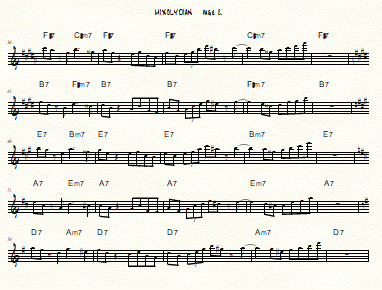
This post defines the Mixolydian Mode and shows how you can use it in your music. Click here to watch the video.
The Mixolydian Mode is related to your familiar major scale, except that it begins and ends on SO instead of DO.

NOTE: All charts in this post are for Bb instruments. A transposition table is provided at the end of this post for your reference.
The similarities and differences between the two are easier to spot when they are seen in parallel.

In the Mixolydian Mode, the seventh degree is lowered. That “flat 7” has been referred to as “the first blues note.” That’s why blues harmonica players choose an F blues harp when playing a C blues. They need that bluesy flatted 7th, the B flat.
Here’s a phrase you can use over a Mixolydian Mode song like Miles Davis’ “All Blues,” Herbie Hancock’s “Watermelon Man,” Herbie’s “Maiden Voyage,” or any blues not requiring a flatted 5th and flatted 3rd.

Here are the rough drafts leading up to the phrase shown above.

And here is a complete recording and chart in all 12 keys, in case you want to shed this lick. (But, if you want to learn to play like this WITHOUT a chart, you need “New Ears Resolution”!) Have fun, and don’t forget to “Practice Joy”!
NOTE: Bb instruments begin at bar 1 and play through to the end.
CONCERT KEY INSTRUMENTS: begin at bar 11, play to the end, and loop back to the top.
E FLAT INSTRUMENTS: Begin at bar 56, and loop back to the top.


Transposing
To make notes lay easier in the middle of the staff, the people who originally came up with the rules of notation decided to do it like this: When an instrument such as a sax or a trumpet plays the note “C”, the “key” of that instrument becomes the note on the piano that matches the same pitch. For example, when the pianist plays an “Eb” the Eb alto sax player plays a “C”, and they both sound the same.
If a vote were taken today, we’d probably choose to have the piano stay on “C” and key the instruments on the same pitch, making alto sax an “A” instrument. Then it would be easier to understand our key signatures in relation to the piano. But it’s too late to change the rule now.
Clarinets are” Bb” instruments; tenor saxes are “Bb” instruments, alto saxes are “Eb” instruments, and flutes are “C” instruments. The following is a transposing chart:
| “C” Instruments | “Bb” Instruments | “Eb” Instruments |
| piano, guitar, flute, strings, trombone, vibes, etc. | clarinet, trumpet, soprano & tenor sax | alto & bari sax |
| C | D | A |
| C#, Db | D#, Eb | A#, Bb |
| D | E | B |
| D#, Eb | F | C |
| E | F#, Gb | C#, Db |
| F | G | D |
| F#, Gb | G#, Ab | D#, Eb |
| G | A | E |
| G#, Ab | A#, Bb | F |
| A | B | F#, Gb |
| A#, Bb | C | G |
| B | C#, Db | G#, Ab |
